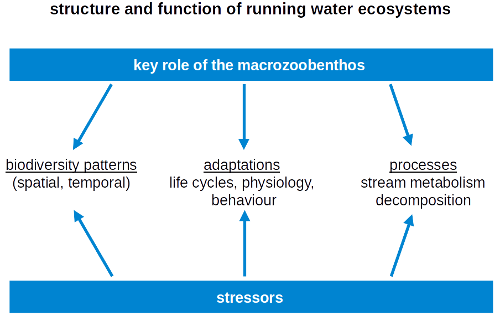Invasion Biology (Model System: Amphipods)
1. Main interest is the invasion of amphipod species to Central Europe. Within the catchment of the River Lippe - a tributary of the River Rhine - the co-occurence of native and non-native amphipod species has been well documented. One of the invaders with origin in southwest Europe (Basque Country) is Echinogammarus berilloni, has been reported for the first time in Germany in the lower Lippe catchment in 1924. Since then the species has been dispersed upstream in the main stem and into tributaries, and since the turn of the millenium reaching its invasion front upstream. Crucial for invasion success is the competition with and eventually displacement of native species (e.g., Gammarus pulex, G. fossarum). In order to understand the patterns and dynamics of the modern regional biodiversity, the underlying mechanisms are studied in comparative field and laboratory experiments on this model system amongst others. Here we test the ecological valences and biological, ecological and physiological life traits on the performance of the species. By studying the metapopulation structures we trace the dispersal history of the species.
2. Global climate change is known to affect physiological processes in charge of cellular stress response. That often results in forcing many organisms to shift their biogeographic distribution ranges. It also holds true for euryoecious and highly invasive species like the killer shrimp, Dikerogammarus villosus. In this study we compare the level of response to thermal stress in two genetically diversified populations of the amphipod D. villosus on the cellular level, namely HSP70 expression. The results show clear difference in HSP70 expression, that can be a direct consequence of the different climatic conditions both populations faced along their invasion routes. We conclude that the eastern population of D. villosus is more sensitive to thermal stress than the western population, hence its invasion potential may be lower than that of the latter. Considering the thermal tolerance of both populations and global warming, we can make some predictions about further spread of D. villosus, including the possibility of an emergence of the super-invader that may arise after cross-breeding of both populations, imposing even larger threat to the freshwater ecosystems.
Hupało, K., Riss, H.W., Grabowsk,i M., Thiel, J., Bącela-Spychalska, K., Meyer, E.I. (2018): Climate change as a possible driver of invasion and differential in HSP70 expression in two genetically distinct populations of the invasive killer shrimp, Dikerogammarus villosus. Biological Invasions, https://doi.org/10.1007/s10530-018-1679-2
Research topics
- Monitoring of the spatial distribution of non-native and native amphipods in intermittent and perennial stretches across catchments
- Invasion history of E. berilloni in northwest Germany
- Dispersal history of Echinogammarus berilloni within the upper River Lippe catchment and at the invasion front
- Ecological traits of native vs. non-native amphipods (preferences, tolerances, activity patterns, population dynamics, feeding, effect of stressors, ...)
- Biotic interactions of E. berilloni, G. pulex, G. fossarum, G. roeselii
- Behavioural and cellular stress response of amphipods (Dikerogammarus villosus, E. berilloni, G. pulex, G. fossarum)
- ...
Collaboration
- Michal Grabowski, University of Lodz, Pl
- Christophe Piscart, Universite de Rennes, F
- Maxim Timofeyev, Irkutsk State University, Ru
- Jochen Koop, Bundesanstalt für Gewässerkunde Koblenz, D
- Ecoring, Hardegsen, D
- Oliver Schmidt-Formann, Municipal Office for the Environment, City of Hamm, D


